BAHAWALPUR

The Abbasi Dynasty
(Daudputra)
MEDALS
Tamgha-e-Daulat (State Medal): instituted by Nawab Sir Sadiq Muhammad Khan IV Abbasi in 1885 to reward state military and civil servants and government employees (Type I – ribbon of equal stripes red/yellow/green. Type II post 1904 – ribbon of equal stripes red/yellow/black).

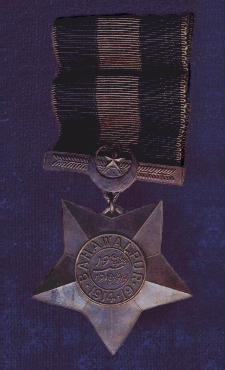
Great War Star - Type I (L) and Type II (R).
Sitara-i-Jang-i-‘Azam (the Great War Star): instituted by Nawab Sir Sadiq Muhammad Khan V Abbasi in 1920 to recognise the services of members of the Bahawalpur State Forces and Bahawalpur subjects who had served in British India units during the Great War. Awarded in bronze in two distinct types (Type I: text in Arabic script with a star and crescent image. Type II: text in both Arabic and English and inscribed “Bahawalpur 1914-1919” around the central medallion).


North-West Frontier Medal - obverse (L) and reverse (R).
North-West Frontier Medal: instituted by Nawab Sir Sadiq Muhammad Khan V Abbasi in 1920 to recognise the services of state troops who relieved British Forces for overseas service by taking over their duties on the North-West Frontier and who subsequently served during the Third Afghan War in 1919. Awarded in two classes, a gilt metal medal for officers and bronze for other ranks.
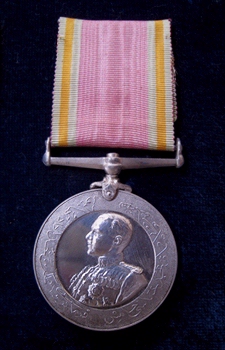
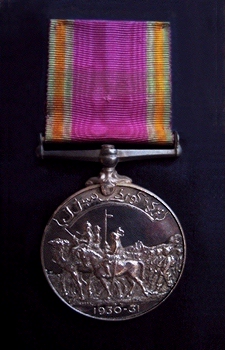
Kot Sabzal Campaign Medal - obverse (L) and reverse (R).
Tamgha-e-Ma'rika Kot Sabzal (the Kot Sabzal Campaign Medal): instituted by Nawab Sir Sadiq Muhammad Khan V Abbasi in 1931 to recognise the services of members of the state forces at the Battle of Kot Sabzal, on the Sindh frontier. Awarded in a single class, a silver medal.

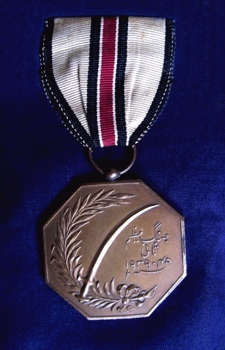
The Second Great War Medal - obverse (L) and reverse (R).
Tamgha-e-Jang-e'Azam Thani 1939-45 (the Second Great War Medal 1939-1945): instituted by Nawab Sir Sadiq Muhammad Khan V Abbasi in 1945 to recognise the services of the Bahawalpur State Forces overseas during the Second World War and also known as the “overseas service medal”. Awarded in a single class, an octagonal bronze medal.
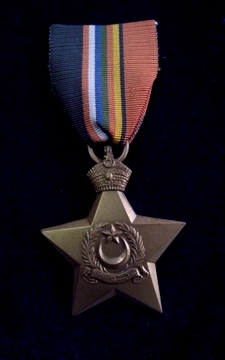
The Victory Star 1939-45, obverse.
Sitara-e-Nusrat 1939-45 (the 1939-45 Victory Star): instituted by Nawab Sir Sadiq Muhammad Khan V Abbasi in 1945 to recognise the services of the Bahawalpur State Forces overseas during the Second World War and to commemorate the Allied victory over the Axis powers. Awarded in a single class, five-pointed dark bronze star.




Military General Service Medal, Type I (L) obverse and reverse, and General Service Medal (Civil), Type I (R) obverse and reverse.
Tamgha-e-Khidmat Ammah Harbia (Military General Service Medal): instituted by Nawab Sir Sadiq Muhammad Khan V Abbasi in 1924 to recognise general military service and good conduct. Awarded in a single class, a cupro-nickel medal, in two distinct types (Type I: circular, Amir bareheaded and wearing military uniform – ribbon of orange bleeding into white bleeding into blue with deep blue edges separated by narrow red stripe. Type II post 1936: circular, Amir wearing fez –green ribbon with edge stripes of red/black/red).


 ...
...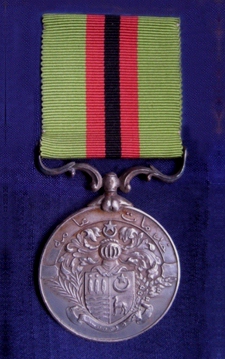
Military General Service Medal, Type II (L) obverse and reverse, and General Service Medal (Civil), Type II (R) obverse and reverse.
Tamgha-e-Khidmat Ammah (General Service Medal) (Civil): instituted by Nawab Sir Sadiq Muhammad Khan V Abbasi in 1924 to recognise faithful service and good conduct by civil servants and state civil employees. Awarded in a single class, a cupro-nickel medal , in two distinct types (Type I: circular, Amir bareheaded and wearing military uniform – ribbon of orange bleeding into white bleeding into blue with deep blue edges separated by narrow red stripe. Type II post 1936: circular, Amir wearing fez –green ribbon with single central stripe of red/black/red).


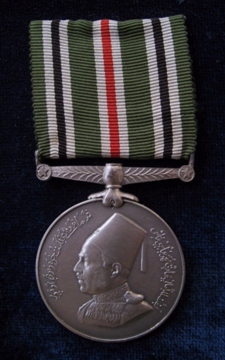

Military Long Service Medal, Type I (L) obverse and reverse,
Type II (R) obverse and reverse.
Tamgha-e-Taweel Khidmat Harbia (Military Long Service Medal): instituted by Nawab Muhammad Bahawal Khan V Abbasi in 1904 to recognise long service and good conduct by members of the Bahawalpur State Forces. Modified by Nawab Sir Sadiq Muhammad Khan V Abbasi in 1924 and 1936. Awarded in a single class, a cupro-nickel medal, in two distinct types (Type I: circular, Amir bareheaded and wearing military uniform – red ribbon with central white stripe, olive green edges, separated by orange stripes. Type II post 1936: circular, Amir wearing fez – olive green ribbon with two black stripes edged white and a central red stripe edged white).
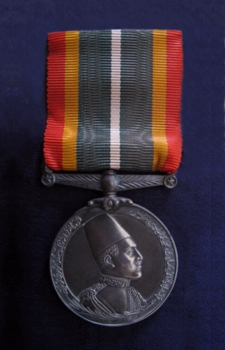
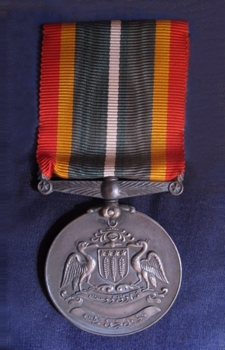
Long Service Medal (Civil), Type I obverse (L) and reverse (R).
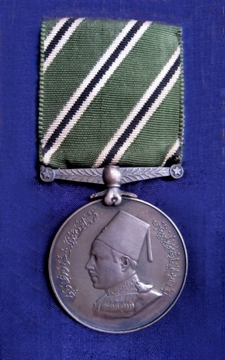

Long Service Medal (Civil), Type II obverse (L) and reverse (R).
Tamgha-e-Taweel Khidmat (Long Service Medal) (Civil): instituted by Nawab Muhammad Bahawal Khan V Abbasi in 1904 to recognise long service by civil servants and state civil employees. Modified by Nawab Sir Sadiq Muhammad Khan V Abbasi in 1924 and 1936. Awarded in a single class, a circular cupro-nickel medal.



Military Good Service Medal, obverse (L) and Good Service Medal (Civil),
reverse (C) and obverse (R).
Tamgha-e-Khidmat Husna Harbia (Military Good Service Medal): instituted by Nawab Muhammad Bahawal Khan V Abbasi in 1905 to recognise distinguished and meritorious service in the Bahawalpur State Forces. Modified by Nawab Sir Sadiq Muhammad Khan V Abbasi in 1924 and 1936. Awarded in a single class, a circular silver medal.


Military Good Conduct Medal, Type I obverse (L) and reverse (R).
Tamgha-e-Husn Amal Harbia (Military Good Conduct Medal): instituted by Nawab Sir Sadiq Muhammad Khan IV Abbasi in 1890 to reward excellence in the Bahawalpur State Forces. Modified by Nawab Sir Sadiq Muhammad Khan V Abbasi in 1924 and 1936. Awarded in a single class, a cupro-nickel medal, in two distinct types (Type I: circular, Amir bareheaded and wearing military uniform – ribbon of equal stripes in red/blue/red separated by narrow stripes in gold with grey edge stripes. Type II post 1936: circular, Amir wearing fez –red ribbon with diagonal stripes of gold/black/gold).


Military Good Conduct Medal, Type II obverse (L) and reverse (R).
Tamgha-e-Husn Amal (Good Conduct Medal) (Civil): instituted by Nawab Sir Sadiq Muhammad Khan IV Abbasi in 1890 to reward excellence by civil servants and state civil employees. Modified by Nawab Sir Sadiq Muhammad Khan V Abbasi in 1924 and 1936. Awarded in a single class, a cupro-nickel medal, in two distinct types (Type I: circular, Amir bareheaded and wearing military uniform – orange ribbon with red edges and a narrow central stripe of dark blue with red edges. Type II post 1936: circular, Amir bareheaded and wearing civilian clothes –red ribbon with diagonal stripes of gold/black/gold).


Good Conduct Medal (Civil), Type I obverse (L) and reverse (R).
Tamgha-e-Jan-e-Nisari (Volunteer Corps Medal): instituted by Nawab Sir Sadiq Muhammad Khan V Abbasi to recognise he services of members of the volunteer and auxiliary forces. Awarded in two classes (1. First Class in silver to officers, 2. Second Class in bronze to other ranks). Separate bars were awarded to recognse particular types of service in four degrees (1. Bravery, 2. Long Service, 3. Good Conduct, and 4. Good Service).
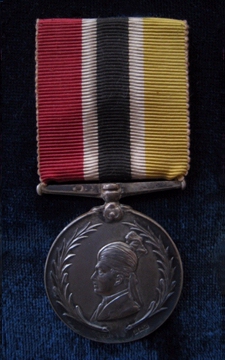


Volunteer Corps Medal - First Class, obverse (L) and reverse (C) -
Second Class, obverse (R).

Volunteer Corps Medal with bars for long service, bravery,
good conduct and good service (top to bottom).
Tamgha Polis (Police Medal): instituted by Nawab Sir Sadiq Muhammad Khan Abbasi V to recognise bravery and distinguished service by members of the Bahawalpur State Police. Awarded in a single class, a silver medal, in two distinct types (Type I: oval, Amir wearing military uniform with fez and facing right. Type II post 1936: circular, Amir bejewelled and wearing a turban and facing left).

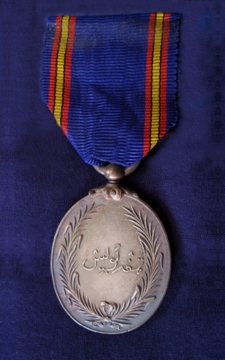


Police Medal - Type I, obverse and reverse (L) - Type II, obverse and reverse (R).
Medal for the Commemoration of the Birth of the Heir Apparent 1880: instituted by Nawab Sir Sadiq Muhammad Khan IV Abbasi in 1880 to commemorate the birth of his son and heir Prince Rahim Yar Abbasi, Wali Ahad Bahadur.
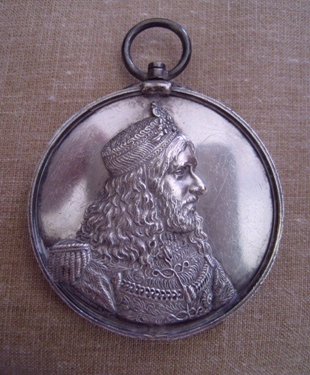

GSCI Commemoration Medal - obverse (L) and reverse (R).
GCSI Investiture Commemoration Medal: instituted by Nawab Sir Sadiq Muhammad Khan IV Abbasi to commemorate his investiture as a Knight Grand Commander of the Most Exalted Order of the Star of India on 26th January 1882. Awarded in a single class, a large circular silver medal.
Household Medal: instituted by Nawab Muhammad Bahawal Khan V Abbasi in 1904 to recognise personal service by noblemen, officers and servants in his household.
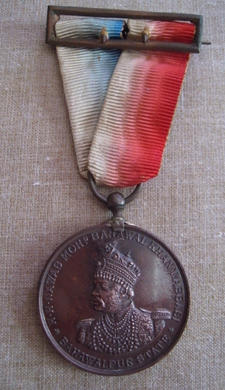

Medal for the Commemoration of the Birth of the Heir Apparent 1904,
obverse (L) and reverse (R).
Medal for the Commemoration of the Birth of the Heir Apparent 1904: instituted by Nawab Muhammad Bahawal Khan V Abbasi to commemorate the birth of his son and heir Prince Sadiq Muhammad Abbasi, Wali Ahad Bahadur, later Nawab Sir Sadiq Muhammad Khan Abbasi V on 29th September 1904. Awarded in two classes (1. First Class in silver, 2. Second Class in bronze).
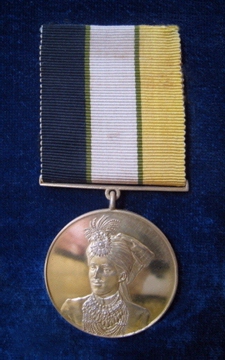

Installation Medal 1924, obverse (L) and reverse (R).
Tamgha-e-Jaloos 1342 Hijri (Installation Medal 1924): instituted by Nawab Sir Sadiq Muhammad Khan V Abbasi to commemorate his installation and investiture with full ruling powers on 8th March 1924. Awarded in three classes (1. First Class in gold. 2. Second Class in silver, and 3. Third Class in bronze).
Medal for the Commemoration of the Birth of the Heir Apparent 1924: instituted by Nawab Sir Sadiq Muhammad Khan V Abbasi to commemorate the birth of his son and heir Prince Muhammad Abbas Abbasi, Wali Ahad Bahadur, later Nawab Muhammad Abbas Khan Abbasi on 22nd March 1924. Awarded in two classes (1. First Class in silver, 2. Second Class in bronze).
Tamgha-e-Jashan Ahad Hukumat Bist-o-Panj (Accession Silver Jubilee Medal): instituted by Nawab Sir Sadiq Muhammad Khan V Abbasi in 1924 to commemorate the celebration of his completion of twenty-five years on the musnaid from 1325 to 1350 AH. Awarded in limited numbers a single class, a circular silver medal. Re-issued in 1949 (see below).
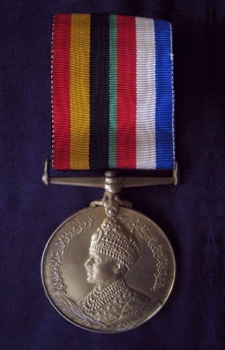

British-Bahawalpur Alliance Centenary Medal, Type II
(Bahawalpur subjects) obverse (L) and reverse (R).
Tamgha-e-Itehad Sadh Sala Bartanja aur Bahawalpur (British-Bahawalpur Alliance Centenary Medal): instituted by Nawab Sir Sadiq Muhammad Khan V Abbasi to commemorate the centenary of the Anglo-Bahawalpur Alliance on 22nd February 1933. Awarded on two types of ribbon, depending on the origins of the recipient (Type I for British subjects – equal stripes of red/white/blue, a divider stripe of green followed by red/yellow/black. Type II for Bahawalpur subjects - equal stripes of red/yellow/black, a divider stripe of green followed by red/white/blue).


Pilgrimage Medal, obverse (L) and reverse (R).
Tamgha-e-Haj (Pilgrimage Medal): instituted by Nawab Sir Sadiq Muhammad Khan V Abbasi to commemorate his act of pilgrimage to the Holy places of Mecca and Mdina in 1935. Awarded in a single class, a circular silver medal.
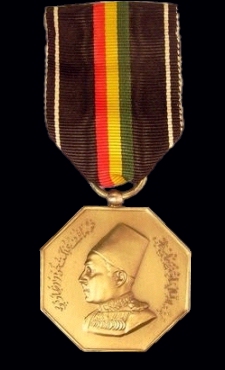

Independence Medal, obverse (L) and reverse (R).
Tamgha-e-Istiqlal (Independence Medal 1947: instituted by Nawab Sir Sadiq Muhammad Khan V Abbasi to commemorate the attainment of independence from Great Britain in 1947. Awarded in a single class, an octagonal cupro nickel medal.
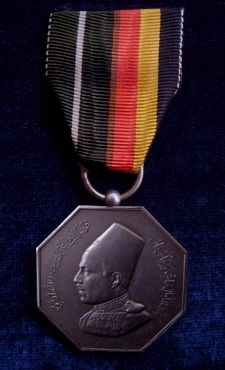
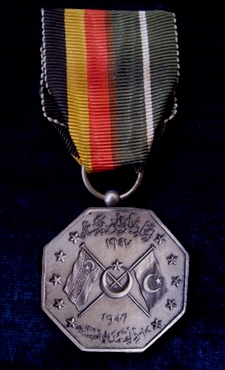
Bahawalpur-Pakistan Alliance Medal, obverse (L) and reverse (R).
Tamgha-e-Itehad Bahawalpur-Pakistan 1947 (Bahawalpur-Pakistan Alliance Medal 1947): instituted by Nawab Sir Sadiq Muhammad Khan V Abbasi to commemorate the accession of Bahawalpur to the Dominion of Pakistan and the conclusion of the treaty of union on 3rd October 1947. Awarded in a single class, an octagonal cupro nickel medal.



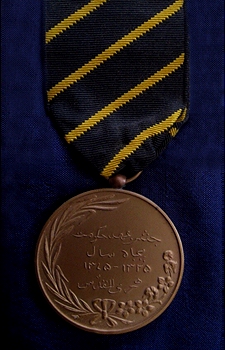
Installation Silver Jubilee Medal (L), second class, obverse and
reverse and Golden Jubilee Medal,((L) secend class,
obverse and first class, reverse.
Installation Silver Jubilee Medal: instituted by Nawab Sir Sadiq Muhammad Khan V Abbasi in 1949 to commemorate the celebration of his completion of twenty-five years since his installation and investiture with full ruling powers from 1342 to 1367 AH. This medal was actually a re-issue of the 1931 Silver Jubilee Medal, which had been awarded in silver in limited numbers. Awarded in 1949 in three classes.
Tamgha-e-Jashan Ahad Hukumat Panjah (Golden Jubilee Medal): instituted by Nawab Sir Sadiq Muhammad Khan V Abbasi in 1955 to commemorate the celebration of his completion of fifty years on the musnaid from 1325 to 1375 AH. Awarded in three classes (1. First Class in gilt bronze, 2. Second Class in bronze, and 3. Third Class in white metal).